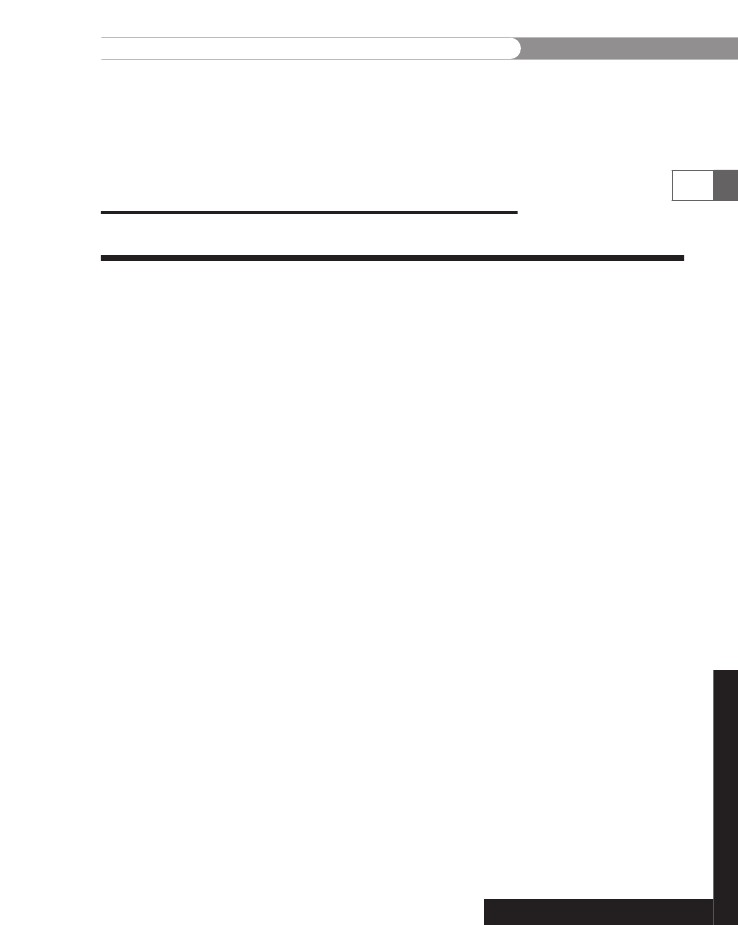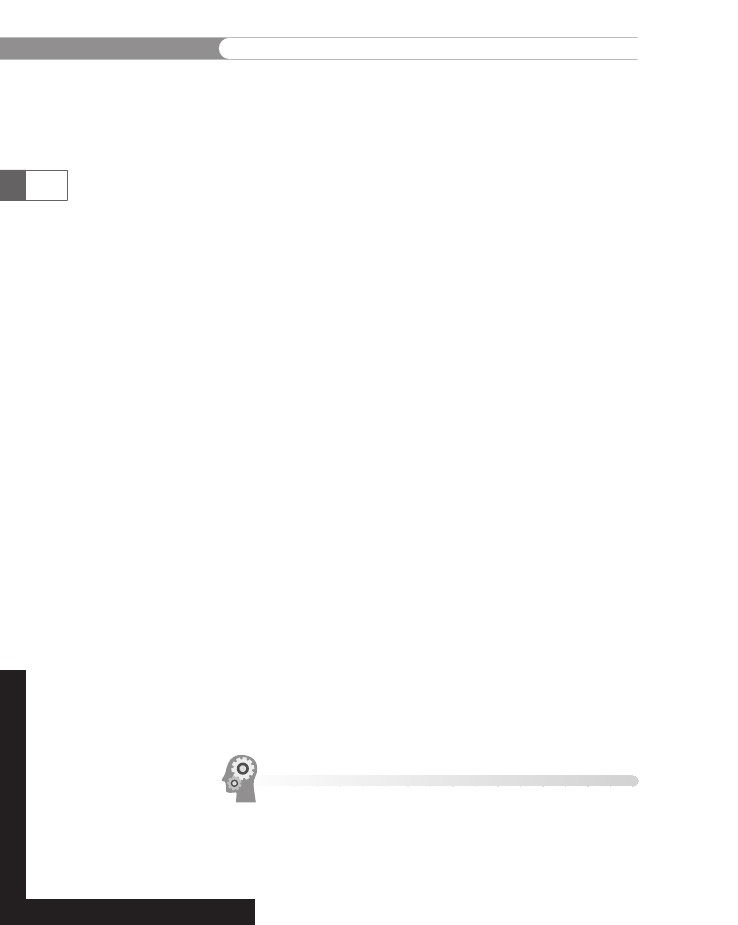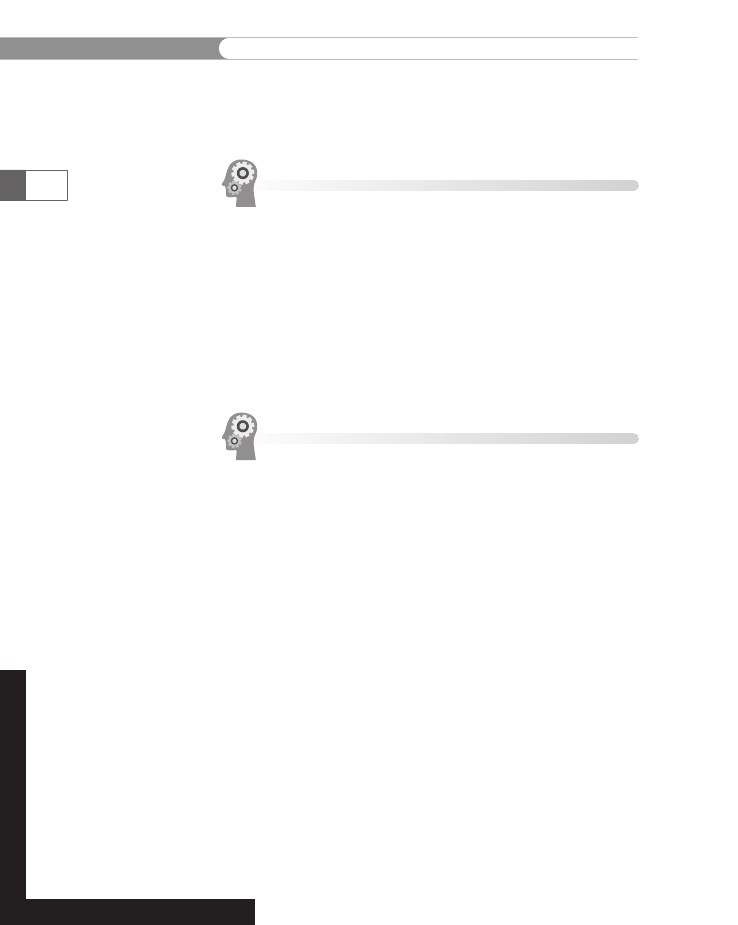
- •Initializing with Constructor Functions . . . . .
- •Into a Web page as a separate section. Although JavaScript code can
- •Is that standard php script delimiters are guaranteed to be available
- •In the block. Any text or lines between the opening /* characters and
- •2.7541 Are not integers; they are floating-point numbers. A floating-
- •Value 300
- •Is a value of 2.5, because 6 goes into 15 exactly 2.5 times. But if you
- •IsEven.Php.
- •Ing example,
- •Ing curly brace is on its own line following the function statements.
- •In php 3 and earlier, it was necessary to put a function definition
- •Is called an iteration. When the conditional expression evaluates
- •Including Files
- •13. Close your Web browser window.
- •Including Files
- •In php, you can also use two operators to combine strings. The first
- •Xhtml source code gen-
- •Input. Php provides several functions for manipulating the case of a
- •Is uppercase. If you need the reverse of ucfirst(), the lcfirst()
- •In some situations, you will need to find and extract characters and
- •Information Interchange, or ascii, which are numeric represen-
- •In comparison, the following preg_match() function returns a value
- •In the pattern is optional. The following code demonstrates how to
- •Values; any strings you validate against a regular expression must
- •Value of 1 because the top-level domain contains a valid value of .Com.
- •Is submitted using the “post” method, the form data is embedded in
- •Validating String Data
- •Xhtml tags or character entities. The message field is a text string
- •Value of the header element. For example:
- •Xhtml code within a php script section.
- •Is typically the person who created the resource. Otherwise, the net-
- •If even a single character of the Web page is sent prior to sending
- •Variables to the file_put_contents() function.
- •Xhtml hyperlink. To download a file from outside the xhtml
- •If...Else statement to display the appropriate version of the mes-
- •Iterating Through an Array
- •Iterating Through an Array
- •In Chapter 2, you learned how to use a foreach statement to iterate
- •Iterating Through an Array
- •Iterating Through an Array
- •In comparison, the following code declares and initializes
- •If ((!file_exists("MessageBoard/messages.Txt"))
- •Values from the array to create a thumbnail gallery of images in which
- •Introduction to Databases
- •Including php, allow you to create Web pages that can read and write
- •Introduction to Databases
- •Information that can be organized into ordered sets of data, and
- •Information. Each recipe in a recipe database, for instance, is a single
- •Introduction to Databases
- •Index, which identifies records in a database to make retrievals and
- •In a single table. However, you might want to break the information
- •Into multiple tables to better organize it into logical sets. Another
- •Information in one of the tables confidential and accessible only by
- •Is the employee information table from Figure 7-1. The related table
- •Is a payroll table that contains confidential salary and compensation
- •Information. Notice that each table contains an identical number of
- •Introduction to Databases
- •Introduction to Databases
- •In a junction
- •Introduction to Databases
- •In a relational format is called a relational database management
- •Is a standard data manipulation language among many dbmSs.
- •Into the query area at the top of the screen or by dragging tables and
- •It is important to understand that even though many dbmSs sup-
- •Introduction to Databases
- •If you ever
- •Is. In comparison, the bigint data type stores integer values between
- •5 Rows in set (0.00 sec)
- •Int);[enter ]
- •Important, these two tabs can cause you to lose all of the data in the
- •Internet Explorer to export the table, click the Save button in the File
- •Ifies the table being changed and the change to make.
- •It easier for you to write php code that can be used with a variety of
- •Information about queries that match one of the following formats:
- •Various types of actions, depending on the type of query.
- •Include fields for the date and time of the flight, flight number, and
- •In the ChineseZodiac folder and upload the file to the server. Open
- •Including white space,
- •Information on a Web server. When you start a new session, the
- •Introduction to Object-Oriented Programming
- •Introduction to Object-Oriented
- •Variables associated with an object are called properties or attributes.
- •In the Loan object example, a function that calculates the number of
- •Introduction to Object-Oriented Programming
- •Introduction to Object-Oriented Programming
- •Include instances of objects inherit the object’s functionality.
- •In this chapter, you will create the Web site for an online order form
- •In an online store application. The application includes information
- •Ity of building a working online store. Online store classes are very
- •Information and products. The OnlineStore class requires that store
- •Information is stored in a table containing six fields: storeId, name,
- •Information. Instead, the class simply uses session iDs to keep track
- •Variable and function as necessary, without bothering with all this
- •In a class
- •Is developed. Imagine what would happen if Microsoft distributed
- •Ing class is invalid because it does not include an access specifier:
- •If they will not be supported by future xhtml versions or are not
- •Xhtml standards. To review the guide of current w3c css specifi-
- •Information to remind yourself or others of what the code is doing. A
- •Xhtml document to the external style sheet. This link informa-
- •If you select Apache from the WampServer menu and select Service
- •Ing code uses the number_format() function to add comma separa-
- •In data that a user submits to a php script.
- •Value of “On” and the display_startup_errors directive is assigned
- •Instead. By looking at the source code, you could see that the value of
- •Ing engine can even help locate logic errors.
- •In Chapter 8, along with the equivalent mssql_* functions, where
- •Inline styles, 632
- •Xhtml, 620–635 (continued)
Working
with Regular Expressions
The
following statements demonstrate how to include and
exclude
numeric characters from a pattern match using the
\d
(digit)
and \D
(not
a digit) character types:
preg_match("/\d/",
preg_match("/\d/",
preg_match("/\D/",
preg_match("/\D/",
"5");
"A");
"5");
"A");
//
//
//
//
returns
returns
returns
returns
1
0
0
1
169
As
a more complex example, the following statement demonstrates
how
to compose the e-mail validation regular expression with class
expressions:
preg_match("/^[\w-]+(\.[\w-]+)*@[\w-
]+(\.[\w-]+)*(\.[a-zA-Z]{2,})$/",
$Email);
Matching
Multiple Pattern Choices
To
allow a string to contain an alternate set of patterns, you separate
the
strings in a regular expression pattern with the |
metacharacter.
This
is essentially the same as using the Or operator (||)
to perform
multiple
evaluations in a conditional expression. For example, to
allow
a string to contain either “vegetarian” or “vegan,” you
include
the
pattern vegetarian
| vegan.
The
following code demonstrates how to check whether a top-level
domain
at the end of a string contains a required value of either .com,
.org,
or .net. The first statement returns a value of 0
because
the URL con-
tains
a top-level domain of .gov,
whereas the second statement returns a
echo
preg_match("/\.(com|org|net)$/i",
"http://www.dongosselin.gov");
// returns 0Value of 1 because the top-level domain contains a valid value of .Com.
echo preg_match("/\.(com|org|net)$/i",
"http://www.dongosselin.com"); // returns 1
Pattern Modifiers
PCRE patterns may be followed by optional pattern modifiers.
Pattern modifiers are letters placed after the closing delimiter that
change the default rules for interpreting matches. The most common
pattern modifier is i, which indicates that the case of a letter does
not matter when searching. Some other pattern modifiers change
how newline characters affect searches. For example, newline char-
acters typically divide an input string into search strings. The m pat-
tern modifier allows searches across newline characters. Also, the s
pattern modifier changes how the . (period) metacharacter works.
Normally, the . metacharacter does not match the newline character,
but it will with the s modifier.

CHAPTER
3
Manipulating
Strings
To
modify the validateAddress()
function
so that it uses regular
expressions
instead of the strpos()
function
to check the format of
the
e-mail addresses in the e-mail script:
1.
170
2.
Return
to the PHPEmail.php script in your text editor.
Modify
the conditional expression in the if
statement
within
the
validateAddress()
function
so it uses the preg_match()
function
instead of the strpos()
function,
as follows:
if
(preg_match("/^[\w-]+(\.[\w-]+)*@" .
"[\w-]+(\.[\w-]+)*(\.[[A-Za-z]{2,})$/i",
$Address)==1)
3.
Save the PHPEmail.php file, upload it to the server, and then
open the file in your Web browser by entering the following URL:
http://<yourserver>/PHP_Projects/Chapter.03/Chapter/
PHPEmail.php. As shown in Figure 3-21, more invalid mes-
sages were found using regular expressions.
Figure 3-21
Output of PHPEmail.php using regular expressions
4.
Close your Web browser window.
Short Quiz
1.
What character is used to match any single character in a
pattern?
How do you specify that you want to ensure that a string con-
tains an actual period and not just any character?
2.

Summing
Up
3.
Describe
the purpose of quantifiers in determining if a string
matches
a pattern.
How
are subexpressions or subpatterns used in a regular
expression?
Describe
the purpose of the |
metacharacter.
171
4.
5.
Summing
Up
•
The
concatenation operator (
operator (.=) can be used to combine two strings.
• An escape character tells the compiler or interpreter that the
character following the escape character has a special purpose. An
escape character combined with one or more other characters is
called an escape sequence.
• Simple string syntax allows you to use the value of a variable
within a string by including the variable name inside a text string
with double quotation marks.
• The type of structure in which variables are placed within curly
braces inside a string is called complex string syntax.
• The most commonly used string-counting function is the
strlen()function, which returns the total number of characters in a string.
• The
str_word_count() function returns the number of words ina string.
• The
strtoupper(), strtolower(), ucfirst(), lcfirst(), anducwords() functions all change the case of characters in the string.
• The
substr() function returns the specified portion of a string.• When applied to text strings, the term “parsing” refers to the act of
dividing a string into logical component substrings or tokens.
• There are two types of string search and extraction functions:
functions that return a numeric position in a text string and those
that return a character or substring.
• You use the
str_replace(), str_ireplace(), andsubstr_replace() functions to replace text in strings.
CHAPTER
3
Manipulating
Strings
•
The
tokens.
• You use the
str_split() or explode() function to split a stringinto an indexed array, in which each character in the string
becomes a separate element in the array.
172
• The
implode() function combines an array’s elements into a singlestring, separated by specified characters.
• The
strcasecmp() function performs a case-insensitive compari-son of strings, whereas the strcmp() function performs a case-
sensitive comparison of strings.
• The
similar_text() and levenshtein() functions are used todetermine the similarity of two strings.
• You can use the
soundex() and metaphone() functions to deter-mine whether two strings are pronounced similarly.
• Regular expressions are a pattern of specially formatted strings
that can be used to validate the structure of a string.
• Regular expressions are made up of both literal characters and spe-
cial characters, called metacharacters, which define the pattern-
matching rules.
• In a regular expression, a backslash character is used to match
metacharacters as literal values.
• Quantifiers are metacharacters that specify the number of times a
particular match may occur.
• Subexpressions are characters contained in parentheses within a
regular expression. The format and quantity of the characters in
the subexpression can be defined as a group.
• A character class is a set of multiple characters enclosed in square
brackets ( [] ) that are treated as a single unit.
• The
| metacharacter allows a string to be composed of an alternateset of substrings. The | metacharacter performs essentially the
same function as the Or ( || ) operator in conditional expressions.
Comprehension Check
1.
Which of the following echo statements is invalid?
a. echo "<p>Welcome to the *combat zone*!</p>";
b. echo '<p>Welcome to the "combat zone"!</p>';

Comprehension
Check
c.
echo
"<p>Welcome to the 'combat zone'!</p>";
d.
echo
'<p>Welcome to the 'combat zone'!</p>';
2.
Which
of the following operators can be used with strings?
(Choose
all that apply.)
a.
.
b.
==
c.
.=
d.
+=
3.
4.
Explain
why you need to use escape characters in strings.
What
is the escape sequence for a single quotation mark?
a.
\\
b.
\'
c.
\~
d.
There is no escape sequence for a single quotation mark.
5.
Which
of the following character sets do you use for complex
string
syntax?
a.
{}
b.
[]
c.
()
d.
// //
6.
Explain
why you need to use complex string syntax. Be sure
to
include an example.
If
you include an array within a text string, you need to use
complex
string syntax. True or False?
Which
of the following functions returns the length of
a
string?
a.
strlen()
b.
strspn()
c.
substr_count()
d.
strcspn()
173
7.
8.
CHAPTER
3
Manipulating
Strings
9.
Which
of the following functions performs a case-sensitive
search
for specified characters in a string and returns a sub-
string
from the last occurrence of the specified characters to
the
end of the string?
a.
substr()
174
b.
strstr()
c.
strrchr()
d.
strpos()
10.
Explain the difference between the two types of extraction
functions.
11. Explain how to determine whether the strpos() function
(and other string functions) actually returns a Boolean value
of FALSE and not a 0 representing the first character in a
string.
12. Which of the following functions allows you to replace
characters within a specified portion of a string?
a. str_ireplace()
b. str_replace()
c. substr_replace()
d. strstr()
13. Explain how to use the strtok() function to break a string
into tokens and then navigate through each token.
14. If you specify an empty string as the second argument of the
strtok() function, or if the string does not contain any of the
separators you specify, the
strtok() function returns a valueof FALSE. True or False?
15. Which of the following functions splits each character in a
string into an array element?
a. str_split()
b. split()
c. explode()
d. implode()

Reinforcement
Exercises
16.
String comparison operators and most string comparison
functions
compare individual characters according to their
ASCII value. True or False?
17. Which of the following functions returns the number of char-
acters you need to change for two strings to be the same?
a. similar_text()
b. levenshtein()
c. soundex()
d. metaphone()
18. Which of the following quantifiers can be used to specify the
quantity of a match in a regular expression? (Choose all that
apply.)
a. question mark (?)
b. minus sign (-)
c. asterisk (*)
d. plus sign (+)
19. A \. is used to match any single character in a pattern. True
or False?
20. Which of the following character pairs match characters at
the beginning and end of a string in a regular expression?
a. \* and *\
b. || and ||
c. ^ and $
d. # and #
175
Reinforcement Exercises
Exercise 3-1
In this project, you will create a script that validates whether a credit
card number contains only integers. The script will remove dashes
and spaces from the string. After the dashes and spaces are removed,
the script should reject the credit card number if it contains any other
non-numeric characters.
CHAPTER
3
Manipulating
Strings
1.
2.
Create
a new document in your text editor.
Type
the <!DOCTYPE>
declaration,
<html>
element,
document
head,
and <body>
element.
Use the strict DTD and “Validate
Credit
Card” as the content of the <title>
element.
Add
the following text and elements to the document body:
<h1>Validate
Credit Card</h1><hr />
176
3.
4.
Add
the following script section to the document body:
<?php
?>
5.
Declare
a $CreditCard
array
that contains three values: an
empty
string, a valid credit card number with numbers and
dashes,
and a credit card number with four initial uppercase
letter
Os.
$CreditCard
= array(
"",
"8910-1234-5678-6543",
"OOOO-9123-4567-0123");
6.
Add the following statements to iterate through each of the
elements in the $CreditCard array to determine if the ele-
ment contains a value.
foreach ($CreditCard as $CardNumber) {
if (empty($CardNumber))
echo "<p>This Credit Card Number is
invalid because it contains an empty
string.</p>";
7.
Add the following else clause to validate the credit card number.
The code uses str_replace() functions to remove any dashes
and spaces in the number. Then, a nested if...else statement
checks whether the new value is numeric. If the number is not
numeric, a warning is displayed. If the number is numeric, the
modified credit card number is displayed in the Web browser.
else {
$CreditCardNumber = $CardNumber;
$CreditCardNumber = str_replace("-", "",
$CreditCardNumber);
$CreditCardNumber = str_replace(" ", "",
$CreditCardNumber);
if (!is_numeric($CreditCardNumber))
echo "<p>Credit Card Number " .
$CreditCardNumber . " is not a valid
Credit Card number because it contains
a non-numeric character. </p>";

Reinforcement
Exercises
else
echo
"<p>Credit Card Number " .
$CreditCardNumber
. " is a valid
Credit Card number.</p>";
}
}
8.
Save the document as ValidateCreditCard.php in the
Projects directory for Chapter 3 and upload the file to the
server.
Open ValidateCreditCard.php in your Web browser by enter-
ing the following URL:
http://<yourserver>/PHP_Projects/Chapter.03/Projects/
ValidateCreditCard.php. Test the script to see if it displays a
message for an empty string, strips dashes and spaces from
the credit card numbers, and identifies which credit card
numbers are valid.
177
9.
10. Close your Web browser window.
Exercise 3-2
In this project, you will create a script that uses comparison operators
and functions to compare two strings to see if they are the same.
1.
2.
Create a new document in your text editor.
Type the <!DOCTYPE> declaration, <html> element, document
head, and <body> element. Use the strict DTD and “Compare
Strings” as the content of the <title> element.
Add the following text and elements to the document body:
<h1>Compare Strings</h1><hr />
3.
4.
Add the following script section to the document body:
<?php
?>
5.
In the script section, declare and initialize two string
variables:
$firstString = "Geek2Geek";
$secondString = "Geezer2Geek"

CHAPTER
3
Manipulating
Strings
6.
178
Add
the following if
statement
to the script section. If both
the
$firstString
and
$secondString
contain
a value, the
statements
in the if
statement
execute. The nested if
state-
ment
uses the comparison operator (==)
to determine if both
strings
are the same. If the strings are not the same, the else
clause
uses the similar_text()
and
levenshtein()
func-
tions
to compare the strings.
if
( !empty($firstString) && !empty($secondString)) {
if
($firstString == $secondString)
echo "<p>Both strings are the same.</p>";
else {
echo "<p>Both strings have "
. similar_text($firstString,
$secondString)
. " character(s) in common.<br />";
echo "<p>You must change " .
levenshtein($firstString,
$secondString) . " character(s) to
make the strings the same.<br />";
}
}
7.
At the end of the script section, add the following else
clause, which executes if either the $firstString or the
$secondString contains an empty value.
else
echo "<p>Either the \$firstString variable or
the \$secondString variable does not
contain a value so the two strings cannot
be compared.
</p>";
8.
Save the document as CompareStrings.php in the Projects
directory for Chapter 3 and upload the file to the server.
Open CompareStrings.php in your Web browser by entering
the following URL:
http://<yourserver>/PHP_Projects/Chapter.03/Projects/
CompareStrings.php.
9.
10. Close your Web browser window.
Exercise 3-3
In this project, you will create a script that uses regular expressions
to validate that an e-mail address is valid for delivery to a user at
example.org. For an e-mail address to be in the correct format, only
Reinforcement
Exercises
username
or
first.last
may
appear before the @ symbol, and only
example.org
or
mail.example.org
may
appear after the @ symbol.
1.
2.
Create
a new document in your text editor.
Type
the <!DOCTYPE>
declaration,
<html>
element,
document
head,
and <body>
element.
Use the strict DTD and “Validate
Local
Address” as the content of the <title>
element.
Add
the following text and elements to the document body:
<h1>Validate
Local Address</h1><hr />
179
3.
4.
Add
the following script section to the document body:
<?php
?>
5.
In
the script section, declare an $email
array
that contains
five
e-mail addresses:
$email
= array(
"jsmith123@example.org",
"john.smith.mail@example.org",
"john.smith@example.org",
"john.smith@example",
"jsmith123@mail.example.org");
6.
Add the following statements to iterate through each of
the elements in the $email array to determine if it is in the
correct format:
foreach ($email as $emailAddress){
echo "The email address “" . $emailAddress .
"” ";
if (preg_match("/^(([A-Za-z]+\d+)|" .
"([A-Za-z]+\.[A-Za-z]+))" .
"@((mail\.)?)example\.org$/i",
$emailAddress)==1)
echo " is a valid e-mail address.";
else
echo " is not a valid e-mail address.";
}
7.
Save the document as ValidateLocalAddress.php in the
Projects directory for Chapter 3 and upload the file to
the server.
Open ValidateLocalAddress.php in your Web browser by
entering the following URL:
http://<yourserver>/PHP_Projects/Chapter.03/Projects/
ValidateLocalAddress.php. Test the script to see if it specifies
8.

CHAPTER
3
Manipulating
Strings
which
e-mail addresses are valid and which are not. The sec-
ond
and fourth e-mail addresses should be invalid.
9.
180
Close
your Web browser window.
Exercise
3-4
A
palindrome is a word or phrase that is identical forward or back-
ward,
such as the word “racecar.” A standard palindrome is similar to
a
perfect
palindrome, except that spaces and punctuation are ignored in
a
standard palindrome. For example, “Madam, I’m Adam” is a
standard
palindrome
because the characters are identical forward or backward,
provided
you remove the spaces and punctuation marks. Write a script
that
checks words or phrases stored in two separate string variables to
determine
if they are a perfect palindrome. If you feel ambitious, see if
you
can modify the program to check for standard palindromes. Save
the
perfect palindrome script as PerfectPalindrome.php and the
standard
palindrome script as StandardPalindrome.php.
Exercise
3-5
Write
a PHP program that checks the elements of a string array
named
$Passwords.
Use regular expressions to test whether each ele-
ment
is a strong password.
For
this exercise, a strong password must have at least one number,
one
lowercase letter, one uppercase letter, no spaces, and at least one
character
that is not a letter or number. (Hint: Use the [^0-9A-Za-z]
character
class.) The string should also be between 8 and 16 charac-
ters
long.
The
$Passwords
array
should contain at least 10 elements, and at
least
six of the elements should fail. Ensure that one entry fails each
of
the five regular expression tests and that at least one fails
because
of
the length. Display whether each password in the $Passwords
array
was
strong enough, and display the test or tests that a password failed
if
it is not strong enough. Save the script as PasswordStrength.php.
Discovery
Projects
The
Chinese zodiac site is a comprehensive project that will be
updated
in the Discovery Projects section at the end of each chapter.
All
files for the site will be saved in a folder named ChineseZodiac in
the
root Web folder on the server.
Discovery
Projects
Discovery
Project 3-1
Create
a new text document in your text editor and include home_
links_bar.inc
at the top of the file. Remember that you will need to
insert
a PHP script section to insert the include file.
Insert
the text from the ChineseZodiac.txt file that you researched in
Discovery
Project 1-3. Format the text using XHTML formatting tags
or
style it with CSS style definitions. Save the file as inc_chinese_
zodiac.php
and upload it to the Includes folder in the ChineseZodiac
folder
on the server. A link to this file will be added in Discovery
Project
4-5.
181
Discovery
Project 3-2
Create
a new text document in your text editor and include home_
links_bar.inc
at the top of the file. Remember that you will need to
insert
a PHP script section to insert the include file.
Insert
content describing the role of PHP in Web development and
why
it has become the highest-rated tool in the Web developer’s
toolkit.
Format the text using XHTML formatting tags or style it with
CSS
style definitions.
Save
the file as inc_php_info.php and upload the file to the Includes
folder
in the ChineseZodiac folder on the server. A link to this file will
be
added in Discovery Project 4-5.
Discovery
Project 3-3
In
your text editor, use XHTML scripting to create a text links bar
with
two text links: PHP and Chinese Zodiac. Format the text using
XHTML
formatting tags or style it with CSS style definitions. These
links
will be enabled in Discovery Project 4-5. Save the file as inc_
home_links_bar.php
and upload the file to the Includes folder in the
ChineseZodiac
folder on the server. A link to this file will be added in
the
Discovery Projects in Chapter 4.
Discovery
Project 3-4
The
levenshtein()
function
and the similar_text()
function
both
calculate
the difference between two strings. Because they use dif-
ferent
algorithms, they can come up with different answers. In this
CHAPTER
3
Manipulating
Strings
project,
you create a script that illustrates the differences by finding
the
most similar Chinese zodiac sign names using the two functions.
1.
182
Create
a new document in your text editor.
Type
the <!DOCTYPE>
declaration,
<html>
element,
document
head,
and <body>
element.
Use the strict DTD and “Similar
Names”
as the content of the <title>
element.
Add
the following text, elements, and PHP script section to
the
document body:
<h1>Similar
Names</h1><hr />
<?php
?>
2.
3.
4.
In
the script section, declare the $SignNames
array
and vari-
ables
to track the smallest value from the levenshtein()
func-
tion
and the largest value from the similar_text()
function.
Note
that the levenshtein()
function
returns the number
of
differences, so a small return value indicates that the two
strings
are similar, while a large return value indicates that
the
two strings are different. In contrast, the similar_text()
function
returns the number of matching characters, so a small
return
value indicates that the two strings are different, while a
large
return value indicates that the two strings are similar.
$SignNames
= array(
"Rat",
"Ox",
"Tiger",
"Rabbit",
"Dragon",
"Snake",
"Horse",
"Goat",
"Monkey",
"Rooster",
"Dog",
"Pig");
$LevenshteinSmallest = 999999;
$SimilarTextLargest = 0;
When search-
ing for the
largest value,
you initialize
your test vari-
able to a number below
the smallest number you
could possibly find (usu-
ally 0). When searching
for the smallest value,
you initialize your test
variable to a number
above the highest number
you could possibly find.
5.
Add the following nested for loops to the end of the script
section. The initial value and conditional of each for loop are
designed so that each element of the array will be compared once
to every other element of the array. Within the inner for loop,
you retrieve the value from the levenshtein() function for each
pair of names and compare the returned value to the smallest
value found so far. If the returned value is smaller, this pair of
names is closer, so you store the returned value as the smallest
Discovery
Projects
value
found so far and save the pair of names associated with
that
value. You then do the same thing with the similar_text()
function,
except that you test for the largest value.
for
($i=0; $i<11; ++$i) {
for
($j=$i+1; $j<12; ++$j) {
$LevenshteinValue =
levenshtein($SignNames[$i],
$SignNames[$j]);
if ($LevenshteinValue <
$LevenshteinSmallest) {
$LevenshteinSmallest =
$LevenshteinValue;
$LevenshteinWord1 =
$SignNames[$i];
$LevenshteinWord2 =
$SignNames[$j];
}
$SimilarTextValue =
similar_text($SignNames[$i],
$SignNames[$j]);
if ($SimilarTextValue >
$SimilarTextLargest) {
$SimilarTextLargest =
$SimilarTextValue;
$SimilarTextWord1 =
$SignNames[$i];
$SimilarTextWord2 =
$SignNames[$j];
}
}
}
183
6.
Add the following code to the end of the script section to dis-
play the pairs of words that the functions determined are the
most similar.
echo "<p>The levenshtein() function has determined that
"$LevenshteinWord1" and
"$LevenshteinWord2" are the most
similar names.</p>\n";
echo "<p>The similar_text() function has determined that
"$SimilarTextWord1"
and "$SimilarTextWord2" are the most
similar names.</p>\n";
7.
Save the document as SimilarNames.php in the
ChineseZodiac directory and upload the file to the server.
Open SimilarNames.php in your Web browser by entering the
following URL:
http://<yourserver>/ChineseZodiac/SimilarNames.php.
Figure 3-22 shows the output.
8.

CHAPTER
3
Manipulating
Strings
184
Figure
3-22
Output
of SimilarNames.php
9.
Close
your Web browser window.
Discovery
Project 3-5
In
this project, you will create a script that determines which of the
12
Chinese zodiac sign names can be made using the letters in each
of
a set of phrases.
1.
2.
Create
a new document in your text editor.
Type
the <!DOCTYPE>
declaration,
<html>
element,
docu-
ment
head, and <body>
element.
Use the strict DTD and
“Embedded
Words” as the content of the
Add the following text, elements, and PHP script section to
the document body:
<h1>Embedded Words</h1><hr />
<?php
?>
3.
4.
In the script section, declare the $Phrases and $SignNames
arrays as follows:
$Phrases = array(
"Your Chinese zodiac sign tells a lot about
your personality.",
"Embed PHP scripts within an XHTML
document.");
$SignNames = array(
"Rat",
"Ox",
"Tiger",
"Rabbit",
"Dragon",
Discovery
Projects
"Snake",
"Horse",
"Goat",
"Monkey",
"Rooster",
"Dog",
"Pig");
185
5.
Add
a function named BuildLetterCounts().
The first state-
ment
converts all of the letters in the string to uppercase. The
second
statement uses the count_chars()
function
to create
an
array of the counts of the 256 ASCII characters. The final
statement
returns the newly created array.
function
BuildLetterCounts($text) {
$text
= strtoupper($text);
$letter_counts = count_chars($text);
return $letter_counts;
}
6.
Add a function named AContainsB(). The function takes
two arrays created by the BuildLetterCounts() function
from Step 5. First, a default return value (TRUE) is set, then the
ord() function is used to get the ASCII values of the first and
last capital letters (‘A’ and ‘Z’). These values define the range of
characters that need to be tested. Finally, you use a for loop
to check the counts for each uppercase letter. At any iteration,
if the count for the current character from array $A is less
than the count for the current character from array $B, the
word cannot be made from the letters in the phrase, so the
return value is set to FALSE.
function AContainsB($A, $B) {
$retval = TRUE;
$first_letter_index = ord('A');
$last_letter_index = ord('Z');
for ($letter_index = $first_letter_index;
$letter_index <= $last_letter_index;
++$letter_index) {
if ($A[$letter_index] < $B[$letter_index]) {
$retval = FALSE;
}
}
return $retval;
}
7.
Create a foreach loop to step through each of the phrases.
Use the BuildLetterCounts() function to create an array of
the counts of the ASCII characters in the phrase. Initialize a
list of the words that can be made as the $GoodWords array,
CHAPTER
3
Manipulating
Strings
and
a list of the words that cannot be made as the $BadWords
array.
foreach
($Phrases as $Phrase) {
$PhraseArray
= BuildLetterCounts($Phrase);
$GoodWords = array();
$BadWords = array();
}
186
8.
Immediately after initializing the $BadWords array, create an
inner foreach loop to step through each of the sign names.
Use the BuildLetterCounts() function to create an array
of the counts of the ASCII characters in the sign name. Use
the AContainsB() function to determine if the sign name
(B) can be made with the letters in the phrase (A). If the
AContainsB() function returns TRUE, add the sign name to
the $GoodWords array. If the AContainsB() function returns
FALSE, add the sign name to the $BadWords array.
foreach ($SignNames as $Word) {
$WordArray = BuildLetterCounts($Word);
if (AContainsB($PhraseArray, $WordArray))
$GoodWords[] = $Word;
else
$BadWords[] = $Word;
}
9.
After the inner foreach loop, add the following code to dis-
play the list of words that can and cannot be made from the
phrase.
echo "<p>The following words can be made from
the letters in the phrase
"$Phrase":";
foreach ($GoodWords as $Word)
echo " $Word";
echo "</p>\n";
echo "<p>The following words can not
be made from the letters in the phrase
"$Phrase":";
foreach ($BadWords as $Word)
echo " $Word";
echo "</p>\n";
echo "<hr />\n";
10. Save the document as EmbeddedWords.php in the
ChineseZodiac directory and upload the file to the server.
11. Open EmbeddedWords.php in your Web browser by entering
the following URL:
http://<yourserver>/ChineseZodiac/EmbeddedWords.php.
Figure 3-23 shows the output.

Discovery
Projects
187
Figure
3-23
Output
of EmbeddedWords.php
12.
Close your Web browser window.
Links
to
Similar
Names.php
and
Embedded
Words.php will be added
in Discovery Project 5-3.

CHAPTER
Handling
User Input
In
this chapter, you will:
Learn
about autoglobal variables
Build
XHTML Web forms
Process
form data
Handle
submitted form data
Create
an All-in-One form
Display
dynamic data based on a URL token
4
Using
Autoglobals
Two
of the most common ways that PHP interfaces with the user are
by
accessing values from fill-in forms that are submitted to a PHP
script
and by handling events, such as dynamically displaying pages
when
the user clicks a hyperlink. The data needed to process these
interactions
is stored in PHP autoglobals.
189
Using
Autoglobals
PHP
includes various predefined global arrays, called autoglobals
or
superglobals,
which contain client, server, and environment
information
that you can use in your scripts. Table 4-1 lists the PHP
autoglobals.
Array
$_COOKIE
$_ENV
$_FILES
$_GET
$_POST
$_REQUEST
$_SERVER
$_SESSION
$GLOBALS
Description
An
array of values passed to the current script as HTTP cookies
An
array of environment information
An
array of information about uploaded files
An
array of values from a form submitted with the “get” method
An
array of values from a form submitted with the “post” method
An
array of all the elements in the $_COOKIE,
$_GET,
and $_POST
arrays
An
array of information about the Web server that served the current
script
An
array of session variables that are available to the current script
An
array of references to all variables that are defined with global
scope
PHP
autoglobals
You
will work
with
most
of
the
autoglobals
in
later
chapters.
Table
4-1
Autoglobals
are associative
arrays,
which are arrays whose elements
are
referred to with an alphanumeric key instead of an index number.
An
example of an associative array is a list of a company’s payroll
information
that uses each employee’s last name instead of an index
number
to refer to elements in the array. To refer to an element in
an
associative array, you place an element’s key in single or double
quotation
marks inside the array brackets. For example, the follow-
ing
statements display three elements of the $_SERVER
autoglobal.
The
$_SERVER["SCRIPT_NAME"]
element
displays the path and name
of
the current script, the $_SERVER["SERVER_SOFTWARE"]
element
displays
the name of the server software that executed the script, and
the
$_SERVER["SERVER_PROTOCOL"]
element
displays the server pro-
tocol
that was used to request the script. Figure 4-1 shows the output.
echo
"<p>The name of the current script is ",
$_SERVER["SCRIPT_NAME"],
"<br />";
echo
"This script was executed with the following server
software:
", $_SERVER["SERVER_SOFTWARE"], "<br />";
echo "This script was requested with the following server
protocol: ", $_SERVER["SERVER_PROTOCOL"], "</p>";

CHAPTER
4
You
will learn
how
to create
associative
arrays
in
Chapter
6.
Handling
User Input
190
Figure
4-1
You
can
use the
getenv()
function to
retrieve the
value of an element in the
$_ENV array.
The
phpinfo()
function dis-
plays the ele-
ments of the
$_ENV array and their
values in the “Additional
Modules” section, under
the “Environment”
heading. You can revisit
the PHPTest.php script
you created in Chapter 1
to see the output of
the phpinfo()
function by opening
http://<yourserver>/
PHP_Projects/Chapter.01/
Chapter/PHPTest.php in
your Web browser.
Most
$_SERVER
and $_ENV
element
values
should not be displayed
on a public Web page
because they contain
important information that
a hacker could use to
identify weaknesses of
the server.
Output of a script that references the $_SERVER autoglobal
As shown in the previous example, the $_SERVER autoglobal contains
information about the Web server and the PHP scripting engine, as
well as detailed information about the current Web page request. The
elements that are available with the $_SERVER autoglobal depend on
the Web server that executes the PHP script.
You can use the $_SERVER["SCRIPT_NAME"] element to include the
full URL path and script name of the current script. This is useful
when creating a link back to the current page, either as the action
attribute of an All-in-One Web form or as a link to a different view
of a Web page template. Both options are discussed later in this
chapter. Use of the similar $_SERVER["PHP_SELF"] element should
be avoided because it includes any additional path information
appended to the URL. Attackers can take advantage of this addi-
tional path information to insert dangerous XHTML code into your
Web page. The $_SERVER["SCRIPT_NAME"] element does not include
additional path information, so hackers cannot use this method to
attack your Web site.
The $_ENV autoglobal contains the environmental variables set for
the operating system on the machine that hosts the Web server.
Environmental variables are variables that programs use to interact
with the system. Unlike the $_SERVER autoglobal, which contains a
predefined list of elements, the $_ENV elements change depending on
the operating system and the machine’s configuration.
As mentioned in Chapter 2, you must use the global keyword to
reference a global variable within the scope of a function. You can
also use the $GLOBALS autoglobal array to refer to the global version
of a variable from inside a function. To refer to a global variable with
the $GLOBALS autoglobal, you use the variable’s name as the key in
single or double quotation marks inside the array brackets. The fol-
lowing example shows a modified version of the script containing the
scopeExample() function you saw in Chapter 2. In this example, the
script references $GlobalVariable using the $GLOBALS autoglobal
instead of the global keyword.

Building
XHTML Web Forms
<?php
$GlobalVariable
= "Global variable";
function
scopeExample() {
echo
"<p>" . $GLOBALS["GlobalVariable"] .
"</p>";
}
scopeExample();
?>
When using
the variable
name as an
index for the
$GLOBALS
array, you omit the lead-
ing dollar sign ($) from
the name.
191
The $_GET, $_POST, and $_REQUEST autoglobals contain data entered
in Web forms and URL tokens. All of these are discussed in greater
detail later in this chapter. The $_FILES autoglobal contains data
about files uploaded to the server using Web forms, as you will learn
in Chapter 5. The $_COOKIE and $_SESSION autoglobals contain dif-
ferent types of state information, which are explained in Chapter 9.
For more information on any of the autoglobals, see the online PHP
documentation at http://www.php.net/docs.php.
Short Quiz
1.
Which element of the $_SERVER autoglobal is used to refer to
the current script?
What keyword is used to reference a global variable within
the scope of a function?
Autoglobals are considered associative arrays. True or False?
2.
3.
Building XHTML Web Forms
Web forms are Web pages with interactive controls that allow users to
enter data in text input boxes, select an option from a drop-down list,
or choose a response from a check box or radio button control. Web
forms also provide a method for electronically submitting the form
data entered by the user to a program on the server that processes the
user’s input.
Web forms are used whenever the server requires information from
the user. For e-commerce sites, order processing and billing are
accomplished via Web forms. Web forms allow visitors to subscribe
to a mailing list or newsletter. Search engine sites use Web forms to
allow visitors to enter search keywords.
A Web form is a standard XHTML page. The only difference is that a
Web form requires a <form> section that contains XHTML markup,
